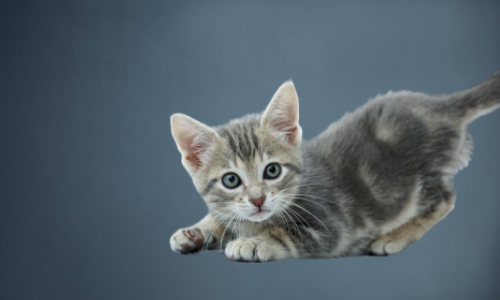Practice Scenario

Meet KITTY
A 3-month-old, spayed-female, mixed-breed kitten
- Kitty is at the clinic for physical examination and vaccination.
- The local animal shelter rescued and spayed Kitty about 3 weeks prior to her adoption by this owner.
- The owner is currently feeding a canned kitten food and wonders about the best way to feed Kitty as she grows.
Kitten
Feeding Kittens
Growing kittens have higher calorie (energy) demands than adult cats. During the first six months, kittens require about twice as many calories per unit of body weight as adult cats. After 6 months of age, their energy demands decrease.
Nutrition should meet an individual kitten’s unique nutritional needs for normal growth while maintaining a lean, healthy body condition. A kitten’s body condition (using the Purina Body Condition System) should be periodically monitored at home and both body condition and weight should be evaluated during veterinary appointments.

Key Messages
To Share With Pet Owner:
Feline Body Condition System Sheet
A visual aid to the Purina Body Condition Score System for cats.
Evaluating Your Cat’s Body Condition
Assess your cat's Body Condition in just 3 simple steps.
Can Dogs and Cats Eat the Same Food?
Cats and dogs have different nutritional needs, so they should be fed food specifically formulated for their species.
Kittens and Adult Cats: The Importance of Staying Lean
Maintaining a lean, healthy body condition in kittens can help prevent obesity and related health conditions in later years.
Decreased Energy Needs in Pets After Spaying or Neutering
Neutering may increase a pet’s risk for becoming overweight or obese.
Additional Resources
Armstrong, P. J., Gross, K. L., Becvarova, I., & Debraekeleer, J. (2010). Introduction to feeding normal cats. In M. S. Hand, C. D. Thatcher, R. L. Remillard, P. Roudebush, & B. J. Novotny (Eds.), Small animal clinical nutrition (5th ed., pp. 361─372). Mark Morris Institute.
Case, L. P., Daristotle, L., Hayek, M. G., & Raasch, M. F. (2011). Canine and feline nutrition: A resource for companion animal professionals (3rd ed.). Mosby Elsevier.
Lawler, D. F. (2008). Neonatal and pediatric care of the puppy and kitten. Theriogenology, 70(3), 384-392. doi: 10.1016/j.theriogenology.2008.04.019
Linder, D. E. (2017). Diets for each life stage. Clinician’s Brief. https://www.cliniciansbrief.com/article/diets-each-life-stage
